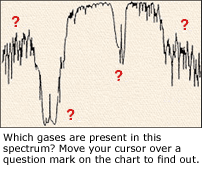|
|||||||||||||||||||
|
A goal of Terrestrial Planet Finder (TPF) is to search for signs of the large-scale effects that life would have on a planet's chemistry. By analyzing the colors of infrared radiation detected by TPF, astronomers can search for atmospheric gases such as carbon dioxide, water vapor, and ozone. Together with the temperature and radius of the detected planets, this information will allow astronomers to determine which planets are habitable, or even whether they may be inhabited by rudimentary forms of life. The best candidates for closer study would be located in the habitable zone; that is, the region around the system's star where we can expect to find liquid water at the surface. If the planet is too hot, the water becomes vapor and is lost from the atmosphere. If the planet is too cold, the water freezes. Either of these conditions would make a planet very inhospitable for life. The habitable zone for our Sun starts beyond Venus and ends before Mars.
Follow the Ozone
The existence of large amounts of oxygen in a planet's atmosphere alone would be a strong indicator of life. In the Earth's atmosphere, oxygen is a byproduct of photosynthesis, the process by which green plants and certain other organisms use sunlight to convert carbon dioxide and water into carbohydrates. Furthermore, oxygen molecules don't remain in the atmosphere, but combine with other molecular types in a process known as oxidation. Therefore, a planet with an atmosphere rich in oxygen (like Earth) would imply a source to keep it replenished (life). However, we know of non-biological processes that can also result in an oxygen-rich atmosphere. The runaway greenhouse effect on Venus is one example. A frozen, Mars-like planet big enough to hold its oxygen would be another. So, the presence of oxygen alone -- while exciting and significant -- couldn't be taken as an unambiguous indicator of life. Furthermore, oxygen doesn't produced spectral lines that can be easily observed in the infrared. However, ozone, a form of oxygen, does. The detection of ozone coexisting with a reduced gas such as nitrous oxide or methane could be taken as convincing evidence not only that a planet is habitable -- but that it may be inhabited. Such large-scale clues can't tell us about the complexity of the discovered life; it could be either algae or a developed civilization. It is also possible that planets without oxygen could sustain life. Photosynthesis might conceivably occur with another element, such as sulfur, playing the role of oxygen. In the search for life, we must control our preconceived assumptions of what it means to be living.
Beyond Terrestrial Planet Finder
The findings of Terrestrial Planet Finder would guide a possible subsequent mission called Life Finder. Like its predecessor, Life Finder would consist of an array of telescopes flying in formation. The telescopes would combine infrared light to produce high-resolution spectra of the atmospheres of distant planets.
Scientists would use this information to search more closely for markers of biological activity, such as seasonal variations in the levels of methane and other gases, changes in atmospheric chemistry and spectral variations in the dominant biomass. Throughout our quest for life, we will have to keep in mind the history of Earth, so far the only confirmed prototype of a world where life has emerged. The simplest life forms existed here well before an abundance of oxygen appeared in the atmosphere, which in turn allowed multicelled organisms to flourish. NASA's astrobiology research will help expand our knowledge of "life signs" that would appear at different stages in a planet's history, as well as signs that would appear given a planetary chemistry that isn't exactly the same as our own. These insights will give us the best possible chance of recognizing life, if and when we find it somewhere else.
|
||||||||||||||||||||||||||||||||
Privacy/Copyright |
Site Map |
Feedback |
Glossary |
Awards & Credits |
For Educators |
For Press |
Widgets |
|
|





